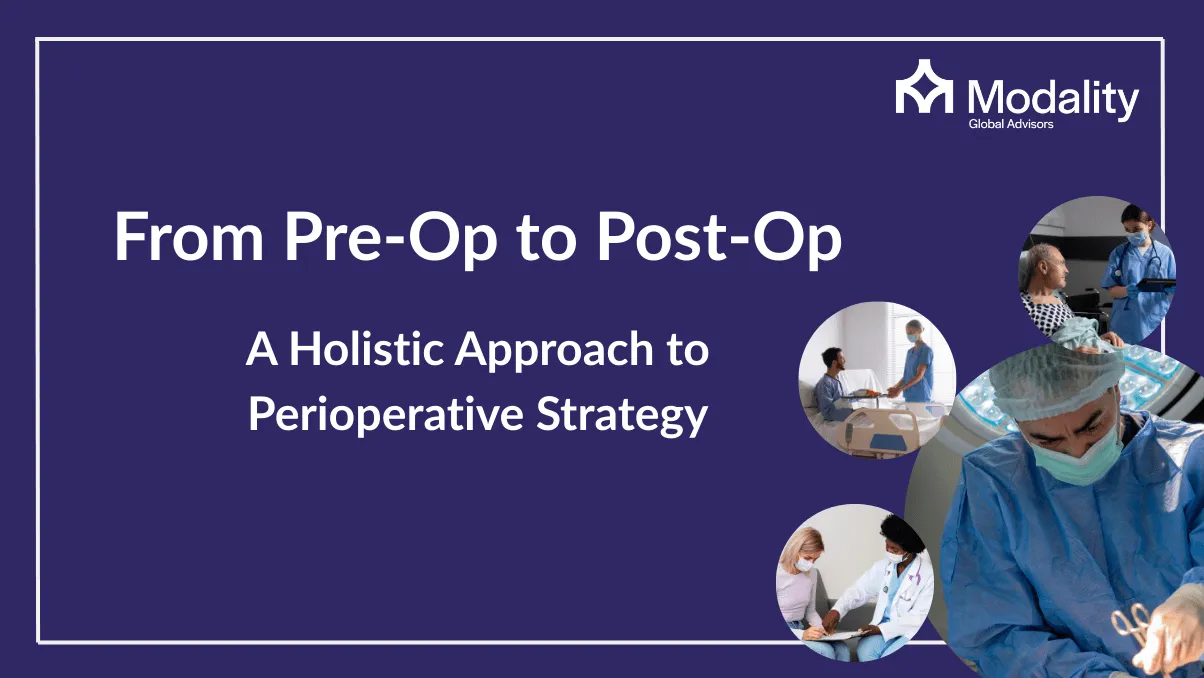Hospitals and health systems are under growing pressure to increase patient throughput in today's rapidly changing healthcare landscape, particularly in high-stakes service areas like oncology and cardiac care. Surgical efficiency alone is insufficient as demand increases and resources become more scarce. Rethinking perioperative strategy as an ongoing, patient-centered journey rather than merely as a stage of care is a truly transformational approach.
At Modality Global Advisors, our upcoming webinar, “Rethinking Patient Throughput: Improving Cardiac & Cancer Service Lines through Perioperative Strategy,” will explore how health systems can transform patient flow, from the initial pre-op evaluation to post-op recovery and discharge.
Why Perioperative Strategy is Pertinent
The entire surgical experience—preoperative, intraoperative, and postoperative—is included in perioperative care. A holistic perioperative approach views these stages as interrelated elements that affect patient happiness, costs, and results, as opposed to the old isolated approach.
Disjointed perioperative processes can result in delays, cancellations, readmissions, and unsatisfactory patient experiences in service lines for cancer and heart disease, where clinical complexity and comorbidities are prevalent. Clinical results and financial performance can both be enhanced by addressing these problems systemically.
The Three Phases of a Holistic Perioperative Model
1. Preoperative Optimization
Effective throughput begins even prior to the patient entering the operating room. Pre-op tactics could consist of:
- Risk stratification and pre-anesthesia evaluations
- Organising diagnostic examinations
- Setting expectations and educating patients
- Optimising scheduling and predicting capacity
In cancer and cardiac care, timely surgical intervention is often critical. A proactive pre-op process helps reduce last-minute cancellations and ensures patients are physically and emotionally prepared for surgery.
2. Intraoperative Excellence
Standardised procedures and well-coordinated personnel fuel efficiency and safety in the OR. Some strategies are:
- Workflows and checklists based on evidence
- Case pairing and lean staffing models
- Supply and equipment preparedness
- Improved communication within the operation
Long turnaround times and surgical delays are expensive. Enhancing these procedures can reduce patient wait times, boost case volume capacity, and free up OR time in high-volume cardiac and cancer programs.
3. Post-Operative Care
After the wound is closed, the surgical process continues. Rapid recovery and a lower risk of problems or readmissions are essential goals of post-operative care. Important strategies consist of:
- Early nutrition and mobilisation procedures
- Integrated discharge planning
- Monitoring and follow-up after discharge
- Pathways for survivability and multidisciplinary rehabilitation
Post-operative care is essential for long-term health in both cardiac and cancer situations. Here, a calculated approach reduces hospital stays and facilitates patients' smooth transition to outpatient care.
Unlock the Full Potential of Your Perioperative Services with Modality Global Advisors
At Modality Global Advisors, we don’t just consult, we co-create smarter, faster, and more compassionate surgical systems. For hospitals tackling the complexities of cardiac and cancer service lines, we bring a powerful blend of clinical insight, operational rigor, and financial strategy to every engagement.
Here’s how we help you lead surgical innovation from the inside out:
Switching the Workflow
In order to boost case throughput, decrease delays, and remove bottlenecks without sacrificing care, we rethink perioperative pathways from the initial patient referral to the last follow-up.
Turn Data Into Direction
We leverage real-time analytics to pinpoint inefficiencies, benchmark outcomes, and drive cost-effective decisions. Because when data speaks, results follow.
Break Down Silos, Build Up Synergy
Our team embeds across departments—surgery, anesthesia, nursing, and administration—aligning every stakeholder around a shared vision of streamlined care and superior outcomes.
Design With the Patient at the Center
Beyond protocols and performance metrics, we focus on what truly matters: the human experience. Every strategy we deliver is crafted to enhance both clinical quality and patient peace of mind.
Final Thoughts
An effective perioperative strategy involves more than just carrying out procedures; it also entails creating a system that helps patients from the time a surgery is planned until they have fully recovered. This comprehensive approach is not only advantageous but also necessary for service lines that deal with cancer and heart disease, where the stakes are high and the margins are narrow.
If you’re ready to reimagine your surgical pathways and enhance patient outcomes, join us for our upcoming webinar: “Rethinking Patient Throughput: Improving Cardiac & Cancer Service Lines through Perioperative Strategy.”

